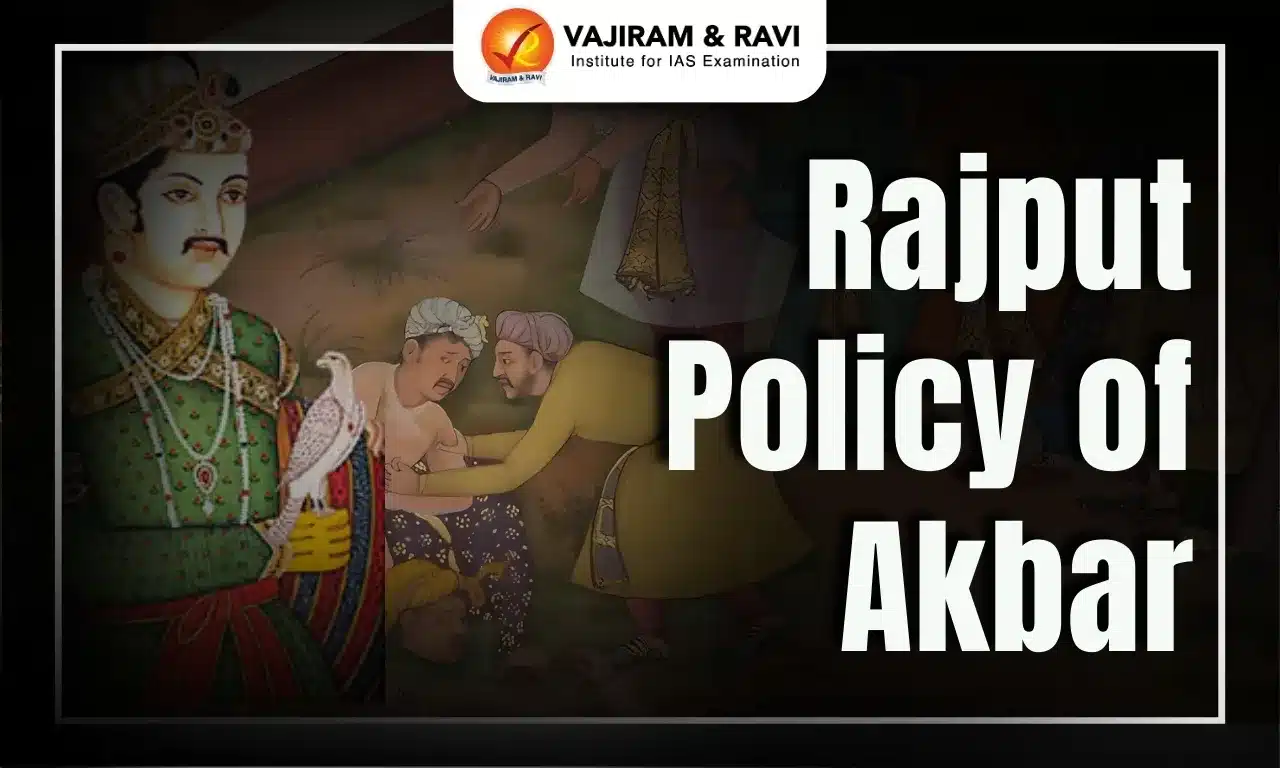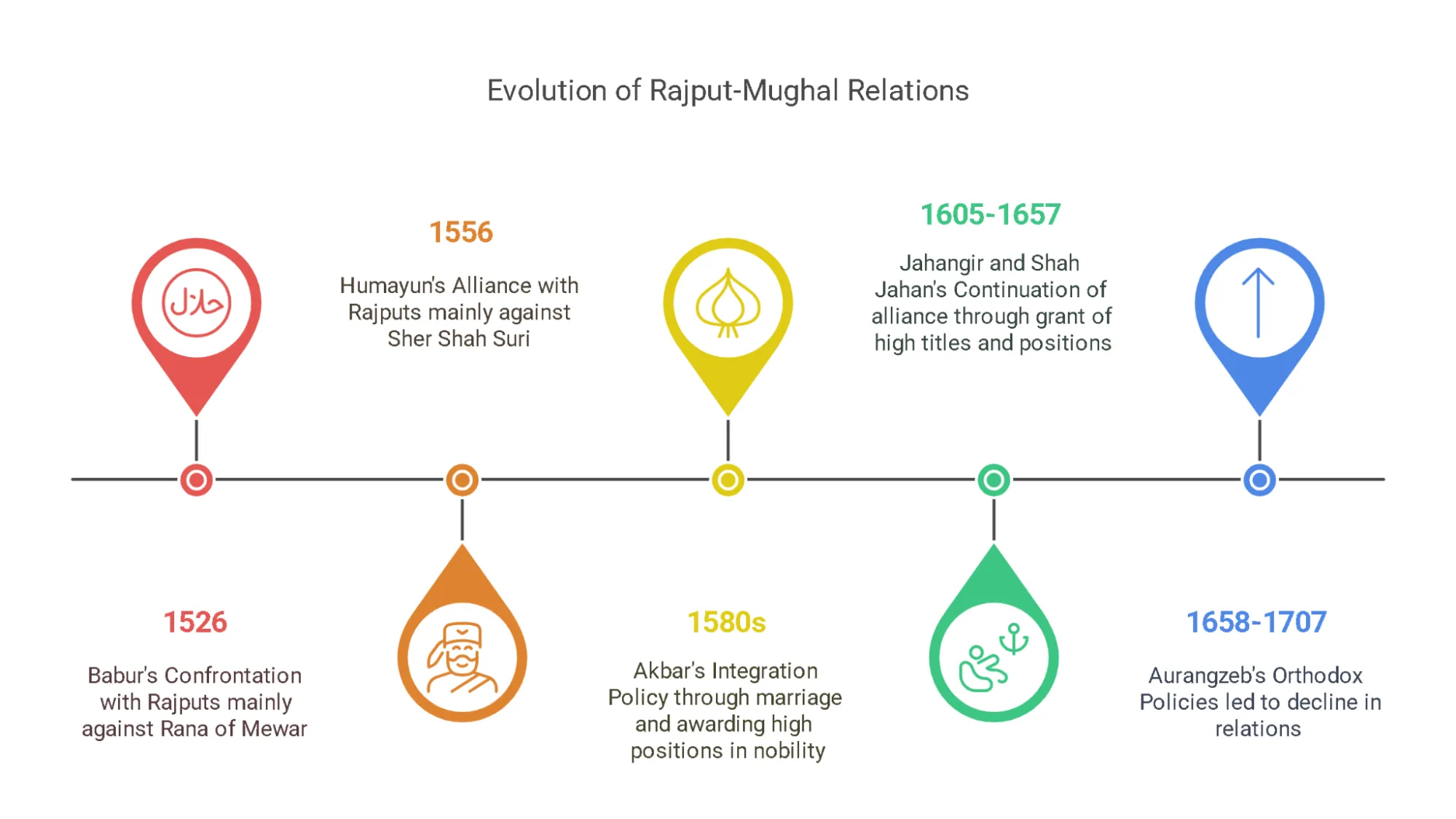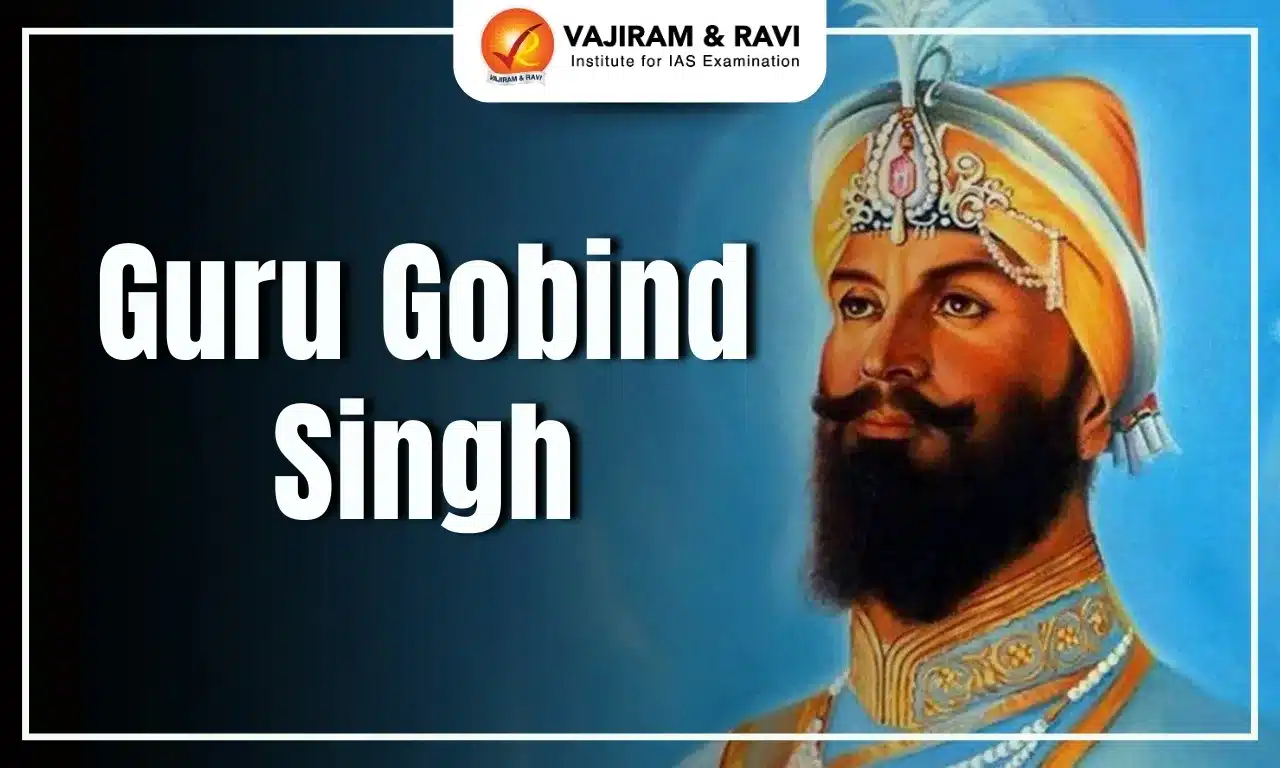Rajput policy of Akbar, a cornerstone of Mughal expansion, involved forming alliances through marriage, integrating Rajput nobility into the court, and promoting religious tolerance, aiming to create a unified and stable empire with the Rajputs as loyal allies. Rajput policy adopted by Akbar was a liberal, inclusive, and strategic policy to gather Rajput support to have a stable and extensive empire.
Rajput policy of Akbar was a significant shift from his predecessors. Akbar was a great pragmatist. He was the first Muslim ruler to recognize that establishing a permanent empire in India required the cooperation of the Rajputs. Thus, Akbar utilized a mix of diplomatic and military strategies to gain control over the Rajputs while also attempting to establish a friendship with them.
Rajput Policy of Akbar Overview
Rajput Policy of Akbar was to make peace with the Rajputs. He realized that it was only possible to have a successful rule over India by integrating the Rajputs into the Mughal control. He pursued a deliberate strategy towards Rajputs. Akbar’s Rajput policy was based on diplomacy, tolerance, and marital alliances. Akbar was highly impressed by the bravery, courage, faithfulness, and combat skills of the Rajputs. He chose to form partnerships with Rajputs instead of making them enemies.
Rajput Policy of Akbar Evolution
Rajput policy of Akbar evolved in the background of a conflictual relationship between Rajputs and Mughals. The relationship grew stronger as a result of Akbar's policy of alliance, before declining under Aurangzeb. The evolution under various Mughal Rulers is discussed in detail below:
- Babur: He was the founder of the Mughal empire and fought against the Rajputs, particularly the Rana of Mewar.
- Humayun: He was Babur’s son, allied with some Rajput kingdoms against Sher Shah Suri.
- Akbar: He aimed for alliance and integration with the Rajputs, establishing marriages and allocating higher positions for them in court.
- Jahangir and Shah Jahan: They continued the alliance and integration with the Rajputs, granting high titles and positions.
- Aurangzeb: His rule deteriorated relations, with a more orthodox Islamic policy and withdrawal of Rajput privileges, leading to resentment and confrontation.
Rajput Policy of Akbar Phases
Rajput policy of Akbar was developed in three phases. The first phase included securing a political alliance with Rajput rulers. The second phase included consolidating those relationships with Rajput rulers. The third phase marks the departure of Akbar from Muslim Orthodoxy. Also, Rajputs became partners with the Mughal administration. These policies became very crucial in the expansion and stability of the Mughal Empire.
- First Phase: During the first phase, till 1569-70, Akbar followed a policy similar to that of the Delhi Sultans, focusing on military conquests and marital alliances. His first alliance was with Raja Bharmal of Amber.
- Second Phase: From 1570 onwards, Akbar strengthened his alliance with Rajputs by incorporating them into the Mughal administration and the army. Rajputs became the sword arm of the Mughal army. The Rajputs became crucial allies during this phase.
- For example, Akbar appointed Raja Man Singh to lead the Mughal army against Rana Pratap in 1576.
- Third Phase: During this phase, after 1580, Akbar’s policy towards the Rajputs became more inclusive and tolerant, showcasing a break with the orthodox ulema. Bhagwant Singh and Man Singh were promoted to high positions. This phase marks the deeper integration of Rajputs in Mughal rule.
- Towards the end of his reign, Akbar promoted a syncretic faith, Din-i-Ilahi, which aimed to blend the best elements of different religions.
Rajput Policy of Akbar Features
Rajput policy of Akbar included diplomacy, marital ties, and military tactics. This strategy sought to secure the allegiance of Rajput kings and create a stable and multicultural empire. The key features of the religious policy of Akbar are as follows,
- Matrimonial Alliances: Akbar established marital alliances with Rajputs. Akbar by marrying the daughter of Raja Bharmal of Amber, Mariam-uz-Zamani, in 1562, Akbar established relations with Amber.
- Inclusion in Nobility: Akbar appointed Rajputs to higher mansab positions in his administration based on their ability and efficiency, like Raja Bhagwan Das and Raja Todar Mal.
- Religious Tolerance: Akbar respected the religious freedom of the Rajputs, allowing them to construct temples, practice their faith, and celebrate their festival.
- Non-interference in Internal affairs: Akbar did not interfere in the internal administration of the Rajput states, who accepted Akbar as their ruler.
- Carrot and Stick: Akbar launched military campaigns against Rajput rulers who did not accept his sovereignty, and after their defeat, Akbar treated them with respect and dignity.
Rajput Policy of Akbar Reasons
Rajput policy of Akbar was not just a diplomatic move but a strategic consolidation and expansion of the Mughal Empire. By forming alliances with the Rajputs, Akbar ensured political stability, strengthened his military support, promoted national unity, and also took advantage of their administrative skills.
- Political Stability: Akbar did not want to have battles with Rajputs because it had been troublesome for previous Mughal rulers and weakened them.
- Expansion of Mughal Empire: The Rajputs controlled strategically essential areas like Mewar, which was necessary for Akbar to take under his control to consolidate and expand his empire.
- Loyal Partners: Akbar had to face conspiracies from people in his court, so he considered the Rajputs as good friends who would ensure his reign’s stability.
- National Ambition: Akbar wanted to become a national Emperor, and for that, the cooperation of Hindus as well as Muslims was necessary for political strength.
Rajput Policy of Akbar Impact
Rajput policy of Akbar strengthened the Mughal Empire by creating a long-lasting allegiance with the Rajputs. This allegiance guaranteed political stability, cultural integration, efficient administration, and territorial expansion of the Mughal Empire. The impacts are mentioned below:
- Expansion of Mughal Empire: Akbar received substantial military support from the Rajput kings to wage battles and capture a number of regions, helping him to expand his empire.
- Economic Prosperity: The friendship with the Rajputs brought about peace and stability, which led to increased economic prosperity for the country.
- Rise of Akbar’s Stature: The Rajputs' acceptance of Akbar allowed him to become a national ruler.
- Inclusive Administration: Rajput rulers were given higher mansabs and essential positions in the administration of Akbar, leading to a balanced administration and polity.
- Cultural Integration: Akbar’s Rajput policy was an example of cultural integration, showcasing his tolerance towards other religions and encouragement of languages such as Sanskrit and Hindi. He also celebrated Hindu festivals, showing his inclusive policies.
- Furthermore, it contributed to the development of a new type of art known as Indo-Muslim Art.
Rajput Policy of Akbar Conclusion
Rajput Policy of Akbar initially started as a political alliance but later evolved into a closer relationship between Hindus and Muslims, promoting a liberal, tolerant policy towards all. The concept of justice expanded, emphasizing justice for all, regardless of religion, caste, or race. The Rajput Policy of Akbar helped in the expansion of the Mughal Empire. However, this policy was strained due to the orthodoxy of the Rajputs and the Mughal elite, who feared a liberal policy would harm their dominant position, resulting in the decline of Mughal-Rajput relations.
Last updated on December, 2025
→ Check out the latest UPSC Syllabus 2026 here.
→ Join Vajiram & Ravi’s Interview Guidance Programme for expert help to crack your final UPSC stage.
→ UPSC Mains Result 2025 is now out.
→ UPSC Notification 2026 is scheduled to be released on January 14, 2026.
→ UPSC Calendar 2026 is released on 15th May, 2025.
→ UPSC Prelims 2026 will be conducted on 24th May, 2026 & UPSC Mains 2026 will be conducted on 21st August 2026.
→ The UPSC Selection Process is of 3 stages-Prelims, Mains and Interview.
→ UPSC Result 2024 is released with latest UPSC Marksheet 2024. Check Now!
→ UPSC Toppers List 2024 is released now. Shakti Dubey is UPSC AIR 1 2024 Topper.
→ Also check Best IAS Coaching in Delhi
Rajput Policy of Akbar FAQs
Q1. Who introduced the Rajput policy?+
Q2. What was the Rajput Policy?+
Q3. What was the reason Akbar followed a liberal policy towards Rajput?+
Q4. How did the Rajput policy of Akbar affect religious tolerance?+
Q5. Which Rajput ruler did not join the Rajput policy of Akbar?+


















